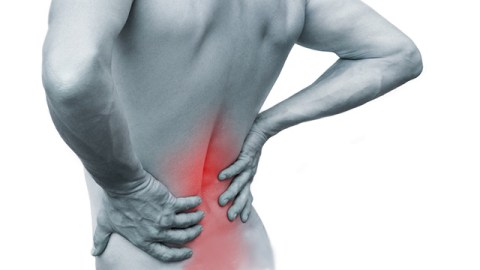Antibiotics for Back Pain

It sounds preposterous: antibiotics for back pain? What on earth could antibiotics possibly do for back pain?
Then again, it sounded preposterous when Barry J. Marshall and J. Robin Warren said, back in 1984, that peptic ulcers were the result of bacterial infection (and could therefore be treated with antibiotics). Careful research proved Marshall and Warren right, and they went on to win a Nobel Prize.
Now comes evidence from researchers in Denmark and the UK that in some (not all) cases, lower back pain may actually stem from bacterial infection. It’s long been known that Type 1 Modic Change (MC, or “bone edema”) in vertebrae is a frequent sequel to disc herniation in patients with back injury, and it is strongly associated with lower back pain. Vertebral MC is actually a surprisingly common condition: it occurs in 6% of the general population and 35% to 40% of people who suffer lower back pain.
Speculating that vertebral MC might have both a mechanical cause and an infective component, Hanne B. Albert and colleagues of the Spine Centre of Southern Denmark decided to look for bacteria in the disc-nucleus material from patients undergoing spine surgery for lumbar disc herniation. Cultures were positive for 28 out of 61 patients. Of the 28 positives, 26 were positive for the anaerobic organism Propionibacterium acnes, a germ that occurs normally in mouth and skin. In patients with the anaerobic bacteria, 80% developed MC in vertebrae adjacent to the area of herniation, whereas only 44% of patients with negative cultures developed MC.
In a separate study, reported in The European Spine Journal, Albert et al. enrolled 162 patients with back pain into a double-blind trial. The patients’ only known illness was chronic lower back pain (6 months or more in duration) as a result of disc herniation and subsequent development of MC. (None of the patients had been involved in surgery.) The back-pain sufferers were randomized into two groups: a placebo group, and a group given amoxicillin and clavulanic acid daily for 100 days. Result: Patients who took the antibiotics improved on all outcome measures, in statistically highly significant fashion, not only at the end of 100 days but one year later. Based on these results, the researchers say antibiotics should be considered a treatment option for Type 1 MC-related back pain.
The work of Albert et al. validates and builds on previous work by Alistair Stirling and colleagues (and others), who found Propionibacterium in degenerated lumbar intervertebral discs.
But the question remains: How do bacteria normally found in mouth and skin make their way into lumbar discs? The answer may surprise you. Albert et al. speculate that “these anaerobic mouth and skin commensal organisms gain access to the disc during normal bacteremias as a result of the neovascularization associated with disc degeneration or herniation.” If you stumbled over the part that said “during normal bacteremias,” congratulations: You’re getting close to the crux of the matter.
Bacteremia is when live bacteria are found in the bloodstream, and it’s far from a normal condition, because ordinarily, blood is sterile. What could possibly be meant, then, by “normal bacteremias”? The answer is that short-lived, subclinical episodes of bacteremia are not uncommon. The typical entry point for bacteria arriving in the blood is the periodontal space (and/or the gums themselves, in the case of gingivitis). You don’t have to have periodontal disease or gingivitis to experience bacteremia, however. Any dental procedure, even vigorous brushing of the teeth, poses the risk of a bacteremic event.
Bacteremia is also possible when boils (pimples, carbuncles) are traumatized, whether deliberately (through incision) or accidentally (e.g., by shaving). Obviously, any open skin wound is also an invitation to bacteremia.
Bacteremia is also a common complication in urinary tract infections.
“Normal bacteremias” are short-lived. They’re “normal” in the sense that they’re common and result in no pathology (usually).
Even a “normal” bacteremia can lead to trouble, though, because once bacteria enter the blood, they look for areas of inflammation in which to congregate and take up residence. So for example: catheters, implants, sore joints, slipped discs, and inflamed coronary arteries are all potential sites for bacterial occupancy. (Take note: the connection between periodontal disease and heart disease is well established. After adjusting for age, sex, diabetes status, serum total cholesterol, smoking, and hypertension, death rate for coronary heart disease goes up by a factor of two for people with gingivitis or missing teeth.)
What it means is that if your gums bleed when you brush (or if you have a problem with boils or acne), you could (arguably) be at risk for a variety of ailments, from heart disease to arthritis to chronic lower back pain. What can you do? One action that suggests itself is to stock up on mouthwash and use it to sterilize your mouth before (not after) you brush. (You can’t actually sterilize your mouth with mouthwash, of course, but you should be able to reduce the number of live bacteria by several orders of magnitude.) Also, be careful shaving. Plus, do what you can to avoid urinary infections.
And remember what your mom told you. Don’t pick at that boil.
If you found the information given here useful, please share this page’s URL with anyone you know who might benefit. Thanks!





